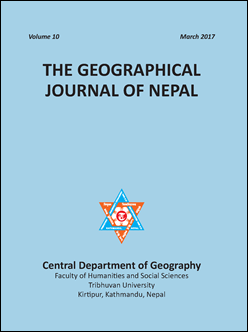Myth and reality of the eco-crisis in Nepal Himalaya
DOI:
https://doi.org/10.3126/gjn.v10i0.17389Keywords:
Community-forestry, degradation, deforestation, eco-crisis, environment, globalization, Himalaya, diversification, mythAbstract
The Himalaya extends from the Pamir in the west to the valley of the Brahmaputra in the east for nearly 2,500 km and passes through Pakistan, India, China, Nepal and Bhutan. The Himalayan area by virtue of its complex geologic structure, snow-capped peaks, a variety of natural landscapes, mountain peoples of unique socio-cultural diversities and adaptation mechanisms has attracted outsiders from the past. The favorable government policies and peaceful native people of the Nepal Himalaya have welcomed thousands of tourists, trekkers and researchers to fulfill their various aspirations and interests. However, the country is often blamed for causing the so-called eco-crisis in the region. During the 1970s and 1980s, publishing several books and articles with attractive titles, some mountain experts showed solidarity with those who propounded a hypothetical theory of Himalayan environmental degradation on the basis of the limited samples collected from a few localities. In this context, the present study is an attempt to review the available literatures and case studies in order to evaluate the potentiality of the so called eco-crisis/environmental degradation in the Nepal Himalaya areas. It also attempts to analyze the present scenarios in relation to the key factors within the area to judge its validity.
The Geographical Journal of Nepal Vol. 10: 39-54, 2017
Downloads
842
1946
Downloads
Published
How to Cite
Issue
Section
License
© Authors




